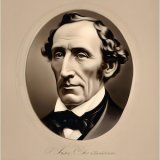The Will-O-the Wisp is in the Town, Says the Moor Woman Page #2
The Will-O-the Wisp is in the Town, Says the Moor Woman is a short folk tale by Hans Christian Andersen. The story involves a conversation between a Moor-woman and her son about the elusive Will-O-the-Wisp. Meanwhile, the Will-O-the-Wisp yearns for a place among the other elements – earth, fire, water, or air. After many trials, he realizes his place and identity in the grand scheme of nature. This story is an allegory on self-realization, acceptance, and the interconnectedness of all elements in nature.
Genre: Children
Genre: Children
- 18 Views
mother, had stood clipped hedges, but now only ferns and stinging nettles grew there, hiding the scattered fragments of old sculptured figures; the moss is growing in their eyes, but they can see as well as ever, which was more than the man could do who was in search of the Story, for he could not find that. Where could it be? The crows flew past him by hundreds across the old trees, and screamed, "Krah! da!--Krah! da!" And he went out of the garden and over the grass-plot of the yard, into the alder grove; there stood a little six-sided house, with a poultry-yard and a duck-yard. In the middle of the room sat the old woman who had the management of the whole, and who knew accurately about every egg that was laid, and about every chicken that could creep out of an egg. But she was not the Story of which the man was in search; that she could attest with a Christian certificate of baptism and of vaccination that lay in her drawer. Without, not far from the house, is a hill covered with red-thorn and broom. Here lies an old grave-stone, which was brought here many years ago from the churchyard of the provincial town, a remembrance of one of the most honored councillors of the place; his wife and his five daughters, all with folded hands and stiff ruffs, stand round him. One could look at them so long, that it had an effect upon the thoughts, and these reacted upon the stones, as if they were telling of old times; at least it had been so with the man who was in search of the Story. As he came nearer, he noticed a living butterfly sitting on the forehead of the sculptured councillor. The butterfly flapped its wings, and flew a little bit farther, and then returned fatigued to sit upon the grave-stone, as if to point out what grew there. Four-leaved shamrocks grew there; there were seven specimens close to each other. When fortune comes, it comes in a heap. He plucked the shamrocks and put them in his pocket. "Fortune is as good as red gold, but a new charming story would be better still," thought the man; but he could not find it here. And the sun went down, round and large; the meadow was covered with vapor. The moor-woman was at her brewing. It was evening. He stood alone in his room, and looked out upon the sea, over the meadow, over moor and coast. The moon shone bright, a mist was over the meadow, making it look like a great lake; and, indeed, it was once so, as the legend tells--and in the moonlight the eye realizes these myths. Then the man thought of what he had been reading in the town, that William Tell and Holger Danske never really lived, but yet live in popular story, like the lake yonder, a living evidence for such myths. Yes, Holger Danske will return again! As he stood thus and thought, something beat quite strongly against the window. Was it a bird, a bat or an owl? Those are not let in, even when they knock. The window flew open of itself, and an old woman looked in at the man. "What's your pleasure?" said he. "Who are you? You're looking in
Translation
Translate and read this book in other languages:
Select another language:
- - Select -
- 简体中文 (Chinese - Simplified)
- 繁體中文 (Chinese - Traditional)
- Español (Spanish)
- Esperanto (Esperanto)
- 日本語 (Japanese)
- Português (Portuguese)
- Deutsch (German)
- العربية (Arabic)
- Français (French)
- Русский (Russian)
- ಕನ್ನಡ (Kannada)
- 한국어 (Korean)
- עברית (Hebrew)
- Gaeilge (Irish)
- Українська (Ukrainian)
- اردو (Urdu)
- Magyar (Hungarian)
- मानक हिन्दी (Hindi)
- Indonesia (Indonesian)
- Italiano (Italian)
- தமிழ் (Tamil)
- Türkçe (Turkish)
- తెలుగు (Telugu)
- ภาษาไทย (Thai)
- Tiếng Việt (Vietnamese)
- Čeština (Czech)
- Polski (Polish)
- Bahasa Indonesia (Indonesian)
- Românește (Romanian)
- Nederlands (Dutch)
- Ελληνικά (Greek)
- Latinum (Latin)
- Svenska (Swedish)
- Dansk (Danish)
- Suomi (Finnish)
- فارسی (Persian)
- ייִדיש (Yiddish)
- հայերեն (Armenian)
- Norsk (Norwegian)
- English (English)
Citation
Use the citation below to add this book to your bibliography:
Style:MLAChicagoAPA
"The Will-O-the Wisp is in the Town, Says the Moor Woman Books." Literature.com. STANDS4 LLC, 2024. Web. 21 May 2024. <https://www.literature.com/book/the_will-o-the_wisp_is_in_the_town%2C_says_the_moor_woman_2260>.




Discuss this The Will-O-the Wisp is in the Town, Says the Moor Woman book with the community:
Report Comment
We're doing our best to make sure our content is useful, accurate and safe.
If by any chance you spot an inappropriate comment while navigating through our website please use this form to let us know, and we'll take care of it shortly.
Attachment
You need to be logged in to favorite.
Log In